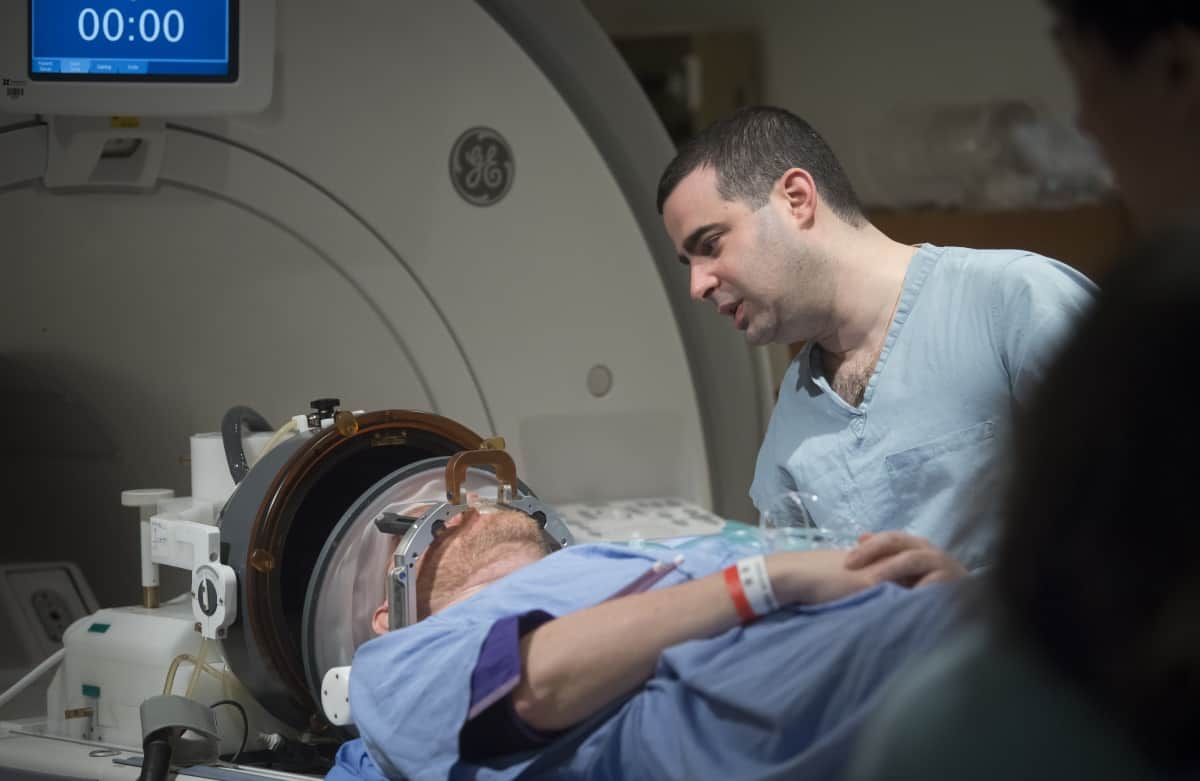
“Focused ultrasound is a rapidly expanding field – and if you look at research publications covering focused ultrasound in the brain, there’s an exponential rise in interest,” said Nir Lipsman, a neurosurgeon at Sunnybrook Health Sciences Centre. “A lot of this is due to the myriad ways in which focused ultrasound can interact with the brain.”
Lipsman was speaking at last week’s 7th International Symposium on Focused Ultrasound, where he described some recent advances in treating brain tumours with focused ultrasound (FUS). While ultrasound may be familiar to most for its use in medical imaging, FUS – which works by focusing multiple ultrasound beams onto targets inside the body – also serves as a therapeutic modality, exploiting a wide range of mechanisms to achieve different physiological effects.
In the brain, high-frequency FUS can be used to generate discrete targeted lesions, while low-frequency FUS, in combination with injected microbubbles, can facilitate drug delivery across the blood–brain barrier (BBB). Other potential applications include transient modulation of brain circuitry, targeted uncaging of nanodroplets for drug delivery and hyperthermia to enhance radiotherapy.
Tackling the BBB
Many of these applications could play a significant role in treating brain tumours, such as glioblastoma multiforme (GBM), the most common malignant brain cancer, which has limited treatment options. One big obstacle is it’s currently not possible to deliver targeted therapies across the BBB and into the brain. Various technologies have been investigated to breach the BBB, but all have cost limitations or associated risks.
FUS, on the other hand, provides a safe and precise way to bypass the BBB. Following injection of microbubbles, FUS is targeted through the skull onto a discrete part of the brain. Microbubbles exposed to ultrasound energy oscillate and physically pull apart cells in the BBB, allowing any circulating drugs to pass through, in concentrations that could ordinarily not be achieved.
“This is a mechanical process that opens up the BBB and does so reversibly,” said Lipsman. “This could be a window that allows us to gain access and deliver therapies.”
Lipsman was part of the team that performed the first human BBB opening in 2015, publishing the results of this first-in-human study last year. The team treated five patients with malignant brain tumours using MR-guided FUS alongside chemotherapy, demonstrating that the approach was safe and feasible.
Since this phase I trial, the technology has evolved to allow treatment of much larger volumes, while upgraded software allows real-time visualization of BBB opening. The team is now running a phase II trial in patients with GBM, to define the safety profile of BBB opening in larger volumes. Lipsman noted that the procedure, which takes 2–3 hr, is performed with the patient awake and usually as a day procedure. “This is the first time that non-invasive day surgery of BBB opening to enhance the delivery of chemotherapy has been performed in large volumes,” he said.

The team is also investigating the use of FUS in patients with metastatic tumours to the brain. In breast cancer, for example, Herceptin can effectively treat breast metastases everywhere in the body, except the brain. The problem is that Herceptin is several orders of magnitude too large to get through the BBB and into the brain.
To address this, the team is now running an ongoing trial of FUS-enhanced Herceptin delivery in breast metastases to the brain. Results from the first two patients show that FUS can safely and reversibly open the BBB, and in highly sensitive regions of the brain. The next steps include radiolabelling the drugs to visualize their passage into the brain.
Liquid biopsy
FUS can also contribute to neuro-oncology in other ways, such as providing an improved way to determine whether a suspicious brain lesion is a tumour, and whether it requires surgical resection or could be treated using chemotherapy or radiotherapy. Currently, this diagnosis requires a brain biopsy, in itself a risky procedure.
Instead, the idea is to use FUS to open the BBB and enable a “liquid biopsy” based on a blood test. Opening the BBB results in increased detection of cell-free DNA – which can be tested to ascertain whether a lesion is cancerous. And the greater volume of BBB opened, the more cell-free DNA is detected in the blood.

Focused ultrasound opens the blood-brain barrier
“A means of opening up the BBB and potentially allowing us to peripherally detect what a lesion is by taking a blood test could lead to a more promising way of making a clinical diagnosis,” said Lipsman. “This will mitigate the need for open neurosurgery exclusively for the purpose of biopsy.”
Lipsman concluded that the many applications of FUS to oncology are arguably its most exciting. “We’re interested in developing this treatment, as are many centres around the world, for primary brain tumours and metastatic brain tumours. And we’re very interested in working with paediatric colleagues and developing applications for children,” he said. “The goal over the next five to 10 years is to run as many trials as we can. This is arguably one of the most exciting and most promising areas of clinical neurosciences.”



